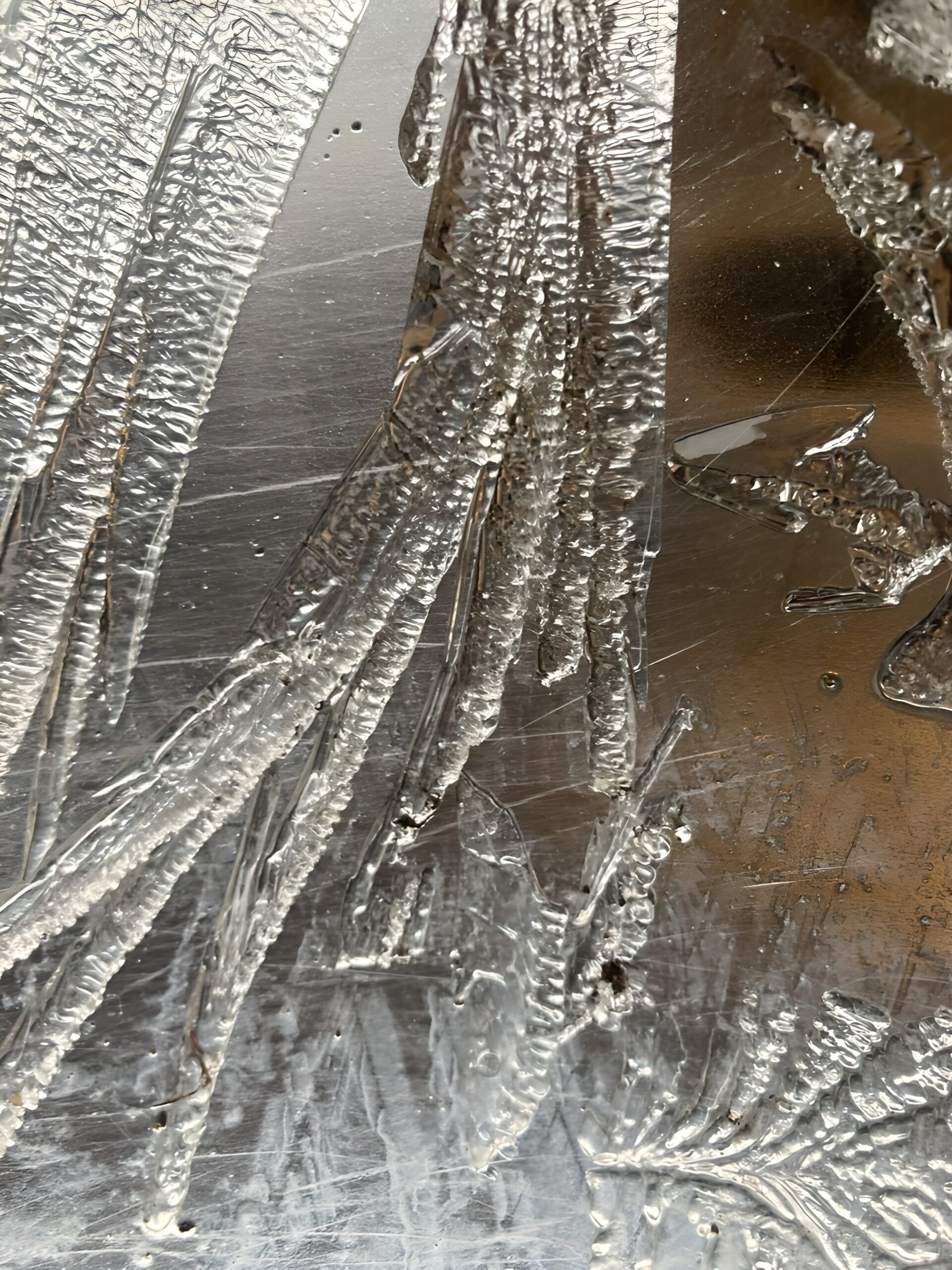1. Visual Analysis
This image captures a world of texture and translucence, where ice and light work in harmony to reveal intricate patterns and layers.
- Composition: The close-up framing immerses the viewer into an abstract landscape of frozen formations. Jagged lines and delicate curves flow across the frame, creating a sense of movement even in stillness.
- Light: Light is the protagonist here. It refracts and reflects off the ice’s surfaces, carving highlights and shadows that accentuate the intricate structure. The contrast between bright, illuminated areas and darker regions adds depth, giving the image a three-dimensional quality.
- Texture: The ice displays a remarkable range of textures—from smooth, glass-like surfaces to rough, crystalline ridges. These tactile variations invite the viewer to imagine the cold, brittle quality of the frozen forms.
- Color: A restrained palette of silvers, grays, and translucent whites dominates. Hints of warm, golden tones peek through the reflection, offering balance and subtle contrast to the cold scene.
- Perspective: The macro-level view transforms the familiar into something otherworldly. Without a clear context, the ice formations become abstract art—shapes, lines, and patterns waiting to be interpreted.
2. Philosophical Reflection
This image is a study of impermanence and fragility—two central themes in Zen philosophy. The ice, though seemingly solid, is temporary. It exists in a fleeting state, caught between water and air, ready to melt and disappear.
- The Beauty of Impermanence: The patterns etched into the ice are unique to this moment in time. They will never be replicated, a visual reminder of Wabi-sabi—the beauty of imperfection and transience.
- The Dual Nature of Strength and Fragility: Ice appears strong and unyielding, yet it is incredibly delicate. A single touch, a rise in temperature, and it shatters or melts. This duality reflects life itself—seemingly solid, yet infinitely fragile.
- A Meditation on Form: The frozen lines twist and flow like rivers captured in time. They invite contemplation of nature’s unseen forces—wind, temperature, and pressure—that shape the physical world, much as unseen forces shape our lives.
The ice does not cling to permanence. It teaches us to accept change, to see beauty in what is fleeting, and to let go when the moment has passed.
3. Practical Photography Insights
This photograph showcases the power of macro photography and the magic of light on texture.
- Embrace Abstraction: Close-up shots of ice, water, or natural textures create abstract images that encourage viewers to see familiar subjects in new ways. Eliminate the background to highlight the subject’s details.
- Work with Light: Ice and other reflective surfaces thrive in natural light. Position your subject where light can filter through or bounce off, creating dynamic highlights and intricate shadows.
- Focus on Texture: Use sharp focus to emphasize the micro-details—cracks, ridges, and patterns. A small aperture (higher f-stop) ensures greater depth of field, keeping the ice formations sharp and defined.
- Play with Contrast: Balance the reflective brightness of ice with darker tones in the background. This interplay of light and shadow adds depth and dimension to the shot.
Tip: Experiment with angles to catch light from different directions. A shift in perspective can completely transform the mood and composition of the image.
4. Reflections
The photograph pulls us into a quiet, frozen world—a place where time pauses, and movement is distilled into crystalline forms. The ice captures what cannot be held: the flowing energy of water, momentarily stilled by cold.
Here, light becomes sculptor, carving delicate paths across its surface. We see lines that resemble veins, fractures, or rivers—each marking a journey. Yet this frozen beauty is a paradox: it exists only because it is impermanent. Soon, the light that reveals its brilliance will also warm it, and the ice will cease to be.
In life, we often seek to hold onto moments, to freeze them as the ice has done. But this image reminds us that the value lies in the fleeting. To observe the ice is to witness a moment on the edge of change—sharp, fragile, and alive. We are invited to see this fragility not as a loss but as a gift, a reminder that beauty does not endure because it was never meant to.
The lesson of the ice: Let go. Watch closely. Be present before it melts.

